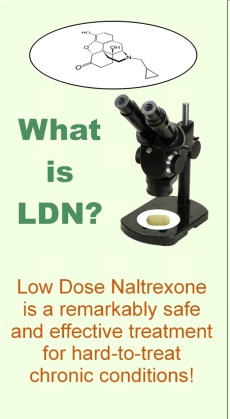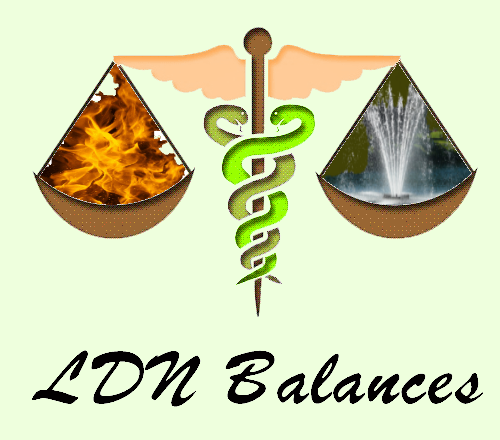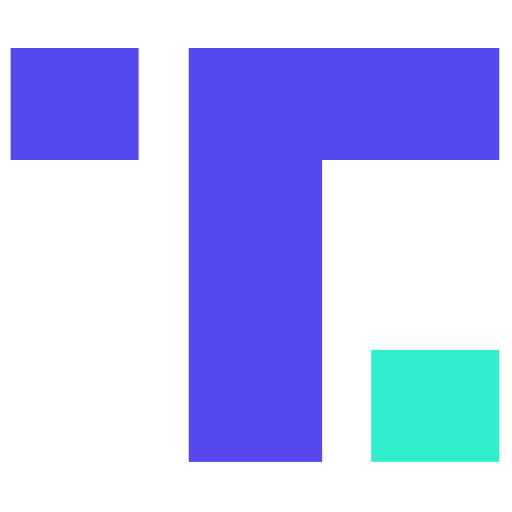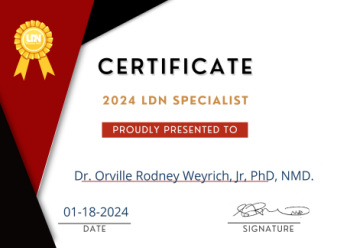
History of LDN
LDN is "Low Dose Naltrexone," which is a specially compounded low dose formulation of the FDA-approved drug, Naltrexone.
Naltrexone was originally licensed by the FDA in 1984 to treat opioid-misuse disorder, and its license was later expanded to include treating alcohol misuse. For these purposes, its mechanism of action is as an opioid-receptor blocker. Its patent has now expired, and so it is now available as an inexpensive generic pharmaceutical.
While the original FDA approval was for doses between 50mg and 200mg/day, it has been discovered that at low doses of about 5mg/day, it exerts very beneficial effects in treating a number of difficult-to-treat disorders.
The use of Low Dose Naltrexone (LDN) in treating a variety of autoimmune, neuroinflammatory, and neurodegenerative disorders, as well as certain microbial diseases and cancers, was pioneered by the late Dr. Bernard Bihari [Bihari2003], [Bihari2013 🕮 ], [LDN]. Please see [LDN_Story] for an excellent documentary video, and [Toljan2018 🕮 ] [Elsegood2016] [Elsegood2020] [Elsegood2022] [Moore2008] for reviews. [Raknes2017 🕮 ] documents a rapid increase in LDN use linked to a TV documentary.
How LDN Works

Low Dose Naltrexone appears to exert its benefits via antagonizing Toll-like Receptors and Opioid Growth Factor receptor (OGF-R).
Other related peripherally-active mu-opioid receptor antagonists (PAMORAs) include naldemedine and methylnaltrexone, which are useful for treating opioid-induced constipation [Umbrello2023 🕮 ]
Treating Chronic Diseases with LDN
According to Dr. Jill Cottel, "most chronic diseases have a component of inflammation and immune system dysfunction." She reports that, out of over 100 patients she has treated with LDN, at least 70% have had a clinical response. Of those patients who responded, about 30% rated their [symptoms] as "much improved" [Elsegood2016, pg xviii]
The following sections mention a few of the more prominent types of chronic diseases that LDN may be be helpful in treating.
Fibromyalgia

The exact cause of this disorder is disputed, but probably is multifactorial. Autoimmunity may be involved, with resultant wide-spread muscle fiber pain and brain fog. Since no organic cause of the disorder can be identified, it is often treated as a somatization (psychosomatic) disorder using antidepressants. LDN has been shown to be a very helpful complementary therapy, possibly due to its blocking TOLL-like receptors [Toljan2018 🕮 ] [Elsegood2016, pp 69 ff] More ...
Chronic Fatigue Syndrome
This disorder has many features in common with fibromyalgia, except that it does not have the wide-spread pain. The exact cause is unknown, but probably is multifactorial, with autoimmune responses, neural inflammation, and reactivation of viruses like EBV and intracellular bacteria like Lyme are thought to be likely.
Since often no organic cause of the disorder can be identified, it is often treated as a somatization (psychosomatic) disorder using antidepressants.
LDN has been shown to be a very helpful complementary therapy, possibly due to its blocking TOLL-like receptors [Elsegood2016, pp 69 ff] More ...
Long Haul COVID and Post-Vax Syndrome
Many of the symptoms of post-COVID and Post-Vax syndrome are similar to another difficult-to-treat condition, chronic fatigue syndrome. LDN has been shown to be a very helpful complementary therapy [Elsegood2022, pp 188 ff] More ...
Inflammatory Bowel Disease and Irritable Bowel Syndrome
There are a number of studies showing that LDN benefits Crohn's Disease, Ulcerative Colitis, and irritable bowel syndrome. Benefits include reduction of the required dose of pharmaceutical medications, reduction in the frequency and severity of flares, and in some cases remission of symptoms [Toljan2018 🕮 ] [Elsegood2016, pp 55 ff] [Elsegood2020, pp 35 ff] More ...
Cancer
LDN blocks the opioid growth factor receptor (OGF-R) on cancerous cells, and in many cases reduces the rate of cancer growth and spread, thereby allowing the immune system to more effectively deal with the cancer. This complementary treatment is compatible with most conventional treatments for cancer, and in many cases has shown to be highly beneficial [Elsegood2016, pp 143 ff] [Elsegood2022, pp 199 ff] More ...
[Bihari2013 🕮 ] [Liu2016 🕮 ] [LDN_Cancer] [Elsegood2016, pp 143 ff] [Elsegood2022, pp 199 ff] have reported that Low Dose Naltrexone has anti-cancer activity, with a beneficial effect on expression of genes involved with cell cycle regulation and immune modulation, including the pro-apoptotic genes BAD and BIK1.
[LDN_Cancer] reports that the late Dr. Bernard Bihari treated approximately 450 patients with some form of cancer, with a 60% success rate, almost all of who had failed to respond to standard treatments. [LDN_Cancer] further reports "of the 354 patients with whom Dr. Bihari had regular follow-up, 86 have shown objective signs of significant tumor shrinkage, ... [and] 125 patients have stabilized and/or are moving toward remission."
Hashimoto's Thyroiditis
This is an autoimmune disease that destroys the thyroid gland. LDN has been shown to reduce the autoimmune antibodies and reduce the need for supplemental thyroid medication [Elsegood2020, pg 27] More ...
Multiple Sclerosis
The strongest evidence for the use of LDN is in treating Multiple Sclerosis. Multiple Sclerosis is the most-studied autoimmune neuro-degenerative disorder, and clinical trials demonstrate remarkable efficacy [Toljan2018 🕮 ] [Gironi2008 🕮 ] [Cree2010 🕮 ] [Elsegood2016, pg 25] [Elsegood2020, pg 28] [Bradley2009]
[LDN] [LDN_MS] reports that all except 2 of the almost 400 patients with MS who were treated by the late Dr. Bihari [Bihari2003] using LDN "experienced a halt in progression of their illness, and "a majority ... note[d] reductions in spasticity and fatigue." This same experience has been reproduced by other practitioners treating well over 2000 MS patients, and holds for both relapsing-remitting and chronic progressive MS.
[EverydayHealth_naltrexone] presents a number of patient reviews of LDN, many of which pertain to MS.
According to [Elsegood2016, pg 49] patients treated with LDN can notice improvements in as little as one month, but the usual experience is slow improvement over up to 18 months More ...

Testimonial / Case Study
65-year-old female with multiple autoimmune and neurological complaints says: "Now I am getting better every day in every way" More ...
Autoimmune Disorders
Autoimmune disorders occur when the immune system becomes "confused" and attacks normal healthy tissue, which causes various diseases More ...
Many patients with autoimmune diseases were successfully treated by the late Dr. Bihari (who pioneered the use of LDN). [LDN] reports that "all have experienced a halt in progression of their illness. In many patients there was a marked remission in signs and symptoms of the disease."
Disorders not already shown above include:
- Graves's Disease [Elsegood2020, pg 27] More ...
- Rheumatoid Arthritis [Elsegood2020, pp 26-27] More ...
- Lupus [Elsegood2016, pp 25 ff] More ...
- Scleroderma (Systemic Sclerosis) [Toljan2018 🕮 ] More ...
- Mast Cell Activation Syndrome [Toljan2018 🕮 ] More ...
- Irritable Bowel Disease (IBS) [Toljan2018 🕮 ] More ...
- Mixed Connective Tissue Disease (MCTD) [Elsegood2022, pp 81 ff] More ...
- Charcot-Marie Tooth Disease [Toljan2018 🕮 ] More ...
- Sarcoidosis [Weinstock2017 🕮 ] More ...
- Mesenteric Panniculitis [Toljan2018 🕮 ] More ...
- Skin conditions [Toljan2018 🕮 ] [Elsegood2020, pp 55 ff] More ...
Neuroinflammatory and Neurodegenerative Disorders
Many neurological disorders appear include a neuro-inflammatory component that responds to LDN's action as a TOLL-like receptor blocker.
Disorders not already shown above include:
- Autism Spectrum Disorder [Toljan2018 🕮 ] [Elsegood2016, pp 131 ff] More ...
- Insomnia [Elsegood2016, pg 47] More ...
- Lyme Disease [Elsegood2020, pp 174 ff] More ...
- Parkinson's Disease [Elsegood2020, pp 71 ff] More ...
- Traumatic Brain Injury [Elsegood2020, pp 115 ff] More ...
- Diabetic Neuropathy [Toljan2018 🕮 ] [Elsegood2020, pg 24] More ...
- Complex Regional Pain Syndrome (CRPS) [Toljan2018 🕮 ] [Elsegood2020, pg 25] More ...
- Cognitive Decline/Alzheimer's More ...
- Depression [Elsegood2016, pp 111 ff] More ...
- Post-Traumatic Stress Disorder [Elsegood2020, pp 152 ff] More ...
- Dissociative Disorders [Elsegood2020, pp 133 ff] More ...
- Restless Legs Syndrome [Elsegood2016, pp 99 ff] More ...
- Amyotrophic Lateral Sclerosis (ALS - Lou Gehrig's Disease) [Toljan2018 🕮 ] More ...
- Postural Orthostatic Tachycardia (POTS) [Weinstock2018 🕮 ] More ...
Chronic Inflammatory Response Syndrome (CIRS)
Chronic Inflammatory Response Syndrome has been associated with mold toxicity, and LDN has been suggested to be helpful in the treatment of this syndrome [Elsegood2022, pp 105 ff] More ...
Safety
A meta-analysis of 89 randomized controlled trials with 11,194 participants was done, and found there was no evidence of increased risk of serious adverse events for naltrexone compared to placebo, and 6 marginally significant adverse events for naltrexone compared to placebo, which were of mild severity [Bolton2019 🕮 ]
Limitations of Low Dose Naltrexone (LDN)
Dr. Weyrich notes that most of the reports here are considered anecdotal; however, given the low cost (less than $40/month) and extremely low side effect profile, a therapeutic trial may be in order.
Since Low Dose Naltrexone is usually prescribed at less than 10% the strength indicated by standard-label guidelines, side effects are similarly expected to be mild, and less than 10% as problematic as when naltrexone is prescribed full strength. The most common side effect is vivid dreams, which can be controlled by appropriate dosing strategies.
The main caveats include [Elsegood2022, pp 217 ff]
- This is an off-label use, and as such is not likely to be covered by insurance. Before prescribing any medication off-label, good medical practice requires appropriate diagnosis and also failure of, or inability to use, standard treatments for the diagnosed condition.
- Dosing must be individualized for each patient, and depends both on a person's genetics and the condition(s) being treated.
- Patients cannot be concomitantly treated with long acting or high doses of opioids (OxyContin, fentanyl, etc).
- Patients cannot be concomitantly treated with anti-rejection (organ transplant) medications.
- To the extent that LDN is effective, dosages of other medications may need to be adjusted; monitoring of potential drug-drug interactions and side effects must be coordinated with all other prescribers. For example, a suspected side-effect of initiating LDN treatment may actually be a sign of an overdose of another medication the patient is taking, and require reduction in the dose of that other medication.
Dr. Weyrich notes that most reports of LDN benefits are considered anecdotal, and without expensive double-blind placebo-controlled trials (which are unlikely to be funded, since LDN is a generic drug that cannot be patented), these results cannot be proven to be anything more than random "spontaneous remissions".
Dr. Weyrich's Qualifications
Dr. Weyrich has been certified (2024) by LDN Research Trust as a Specialist in the use of Low Dose Naltrexone (LDN) and offers these protocols as a complement to other therapies. He has been studying LDN conference proceedings since 2013, and has been prescribing LDN since 2016.







